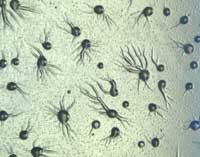Robert Gundersen, Ph.D.
Department Chair
Education:
Ph.D. University of Texas-Austin 1983
B.S. University of Lowell 1979
CV: Download CV
Email: Send an Email
Phone: 207.581.2802
Office: 282 Hitchner Hall
Mailing Address: 5735 Hitchner Hall Orono, ME 04469-5735
Research interests
How do cells respond to extracellular stimuli? What are the components of a cell’s response system and how are these components regulated? Cell stimulus response systems are referred to as Signal Transduction Pathways. A common eukaryotic signal transduction pathway is the G protein-mediated pathway in which G proteins link cell surface receptors to the appropriate effector (response) systems.

We use techniques in cell biology, biochemistry, and molecular biology to examine G protein-mediated signal transduction. The soil amoebae, Dictyostelium is employed and serves as a model system for examining the roles G proteins play in cell physiology.
In Dictyostelium discoideum, a single G protein a-subunit, Ga2, controls entry into the developmental phase of the cell’s life cycle. Ga2 regulates three different effector systems; guanylyl cyclase, adenylyl cyclase and phospholipase C. How activation of each effector occurs through Ga2 and how this translates into the developmental process is being examined. Present research aims to understand how covalent modification of Ga2 by phosphate, myristate and palmitate regulate Ga2 function.
Recent Publications
- Alamer, S., Kageyama, Y., and Gundersen, R. (2018) Localization of palmitoylated and activated G protein α-subunit in Dictyostelium discoideum. J. Cell. Biochem.
